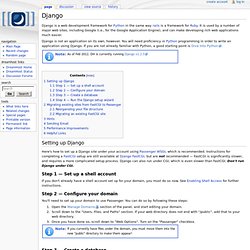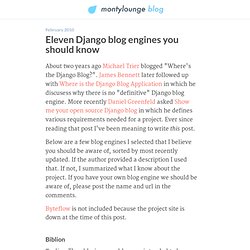

Django-Celery on Webfaction using RabbitMQ. This tutorial is meant to get you up and running from scratch with django-celery on Webfaction.

Each of the steps is a bit of a hassle since you typically need to find different install steps for each individual part, so I just lumped up the whole experience in this guide. Install Erlang Erlang is needed for installing RabbitMQ which is the preferred message broker for Celery. Webfaction doesn't come with this installed, so you'll need to do it manually: Go to the webfaction control panel and create a new app -> Custom App, Listening on PortDownload the latest version of Erlang.
Install RabbitMQ CONFIG_FILE=~/src/rabbitmq_server-2.6.1/sbin/LOG_BASE=~/logs/user/rabbitmqMNESIA_BASE=~/src/rabbitmq_server-2.6.1/sbin/ Added these lines to the rabbitmq-env file and use the ports you reserved for epmd and rabbitmq in your earlier steps: export ERL_EPMD_PORT=12708export RABBITMQ_NODE_PORT=35478export ERL_INETRC=$HOME/.erl_inetrc Added the file $HOME/hosts which looks like:
Bootstrap. The Web framework for perfectionists with deadlines. Le Framework Web python pour les perfectionnistes. The Django Book: Version 2.0 (English) Django. Django is a web development framework for Python in the same way rails is a framework for Ruby.

It is used by a number of major web sites, including Google (i.e., for the Google Application Engine), and can make developing rich web applications much easier. Django is not an application on its own, however. You will need proficiency in Python programming in order to write an application using Django. If you are not already familiar with Python, a good starting point is Dive Into Python. Setting up Django Here's how to set up a Django site under your account using Passenger WSGI, which is recommended. Step 1 — Set up a shell account If you don't already have a shell account set up for your domain, you must do so now.
Step 2 — Configure your domain You'll need to set up your domain to use Passenger. Open the Manage Domains section of the panel, and start editing your domain. Step 3 — Create a database. Installing Django With virtualenv on Dreamhost. Over on twitter, the subject of django on dreamhost came up between @bamana , @jtemple77 and myself . I had installed django on dreamhost late last year for andrew.io , took notes, and the following is how I did it. Note: these instructions are loosly based off of the instructions for django in the dreamhost wiki . Setup Domain and Database If you don’t have a domain and database already setup, you’ll need to get them setup before continuing. This can be done from the dreamhost admin panel . Domain Visit manage domain panel and edit the domain you’re going to use for django. Select the user you want to run django under, and define a web directory. Re: the web directory, it needs to end with /public .
Next, under Web Options: enable the checkbox next to Passenger Database Visit the MySQL Databases Panel , create a database, and make note of the hostname, user, and password you use to create the database. Install django from Dreamhost’s Setup Wizard You’re more or less ready to go. Troubleshooting. South.
Snippets / tips. Eleven Django blog engines you should know. About two years ago Michael Trier blogged "Where's the Django Blog?

". James Bennett later followed up with Where is the Django Blog Application in which he discusess why there is no "definitive" Django blog engine. More recently Daniel Greenfeld asked Show me your open source Django blog in which he defines various requirements needed for a project. Ever since reading that post I've been meaning to write this post. Below are a few blog engines I selected that I believe you should be aware of, sorted by most recently updated. If the author provided a description I used that. Byteflow is not included because the project site is down at the time of this post. Biblion Tagline: The eldarion.com blog app intended to be suitable for site-level company and project blogs. Source: Last updated: Feb 9, 2010 Live example: Description: Biblion was the eldarion.com blog which we've extracted and open sourced.
Notable features: Home - django-cms.org.